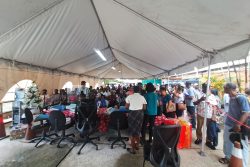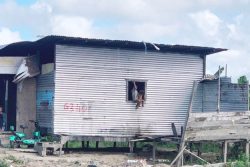Dear Editor,
I refer to an article in the Guyana Chronicle dated February 7, 07 where the Minister of Agriculture stated that the restoration of the hardy mangrove is of paramount importance to the government in order to mitigate the ravages of sea level rise and climate change. The Minister of Transport who was in attendance also stated that moving away from the coast is not an option and that mangrove is an option to protect the coast.
The mangrove in its present form is not hardy and does not protect the coast as claimed. In the ’60s when I was constructing the concrete sea defences at Chateau Margot on the East Coast over ½ mile of mangrove trees collapsed within a space of 3 weeks necessitating working 24 hours a day to protect and hold the sea defence line in that area. Close examination of the mangrove trees revealed that the roots appeared to be too short and thin and therefore could not sustain the onslaught of the erosion that was taking place. Mangrove trees in other areas were also similarly destroyed. Mangrove grows naturally along the coast, disappears during erosion and then re-appears in later years. It is a natural phenomenon in Guyana.
If, however, the government can locate similar trees, which can grow with longer and thicker roots, say 6 feet or more in length, then the experiment could be of some value to the nation, otherwise, spending $1B in my opinion would be a waste of money.
About 20 years ago I gave a copy of an article about a tree used to protect the foreshore in parts of south-east Asia that grows to 5 to 6 ft in height with roots 5ft deep, to the then CHO (presently a top government consultant) who promised to investigate. I never heard anything further from him on the subject.
There has also been a lot of talk by the government and others about the dangers of rising sea levels, but to date it has made no attempt to calculate the present level, which is of primary importance in the design of new sea walls. The sea level being used today for the riprap design if ever being used at all, may be based on guesswork.
Global warming has also been under recent scrutiny, as the data used to prove its existence has been fudged by the IPCC.
Today, the infrastructure works are in a worse state than in 1992 when the PPP came to power, despite spending vast sums of money. During the ’60s and ’70s the Hydraulics Division spent about US$50M on the sea defences that are still in good condition today, despite no maintenance by this government over the years. This government to date has spent over US$100M plus building questionable10-year-old sea defences, and plans to spend another US$18M again this year and now wants to spend a further US$5M to experiment with mangrove protection for the sea defences. All this spending and yet no solution to the sea defence problems are in sight. According to the budget, the mangrove cost has been increased by 20% to US$6M.
At Better Hope on the East Coast over the last 4 years the concrete sea defences built by the undersigned in the ’60s have been taking a battering from the waves, yet no attempt has been made to arrest the situation. The foreshore appears to have been eroded to unprecedented levels, fuelling the wave action and overtopping. A breach in this area cannot be ruled out. Any breach would be calamitous as it would be difficult to repair or re-align the sea defences. The sea defences on the East Coast were re-aligned during the 1960s and there are still a lot of vulnerable areas where no credible sea defences have been built except for earth dams.
Frankly, the government does not have the local engineers, the established institution nor the expertise and experienced local workers any more.
When you consider what the residents on the East Coast are facing from the north and the EDWC from the south it would be worthwhile for the government to consider the option of the dreaded R word – relocation to safer areas. The money earmarked for the Hope Canal and the experiment with the mangroves some US$26M total, could be used for this purpose.
Yours faithfully,
Malcolm Alli





